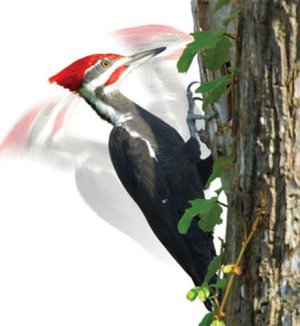Using Football Science to Tackle STEM Education
Your content has been saved!
Go to My Saved Content.More people watch the Super Bowl than vote in a Presidential election.
This fact stopped me in my tracks, and I wondered if the tremendous popularity of football could be used as a way to teach STEM. I took on this challenge with journalist Allen St. John when we wrote a book called Newton's Football, a new title from Random House.
What did we find in terms of science at work on the gridiron? Surprisingly, a lot, and many of the topics fall under the Next Generation Science Standards (NGSS). Let me share a few items, which might be useful to you in your classroom.
Why Don’t Woodpeckers Get Concussions?
We discovered that a woodpecker pecks about 12,000 times a day at an incredible 20 times a second. So why don't they get concussions?
When exploring this, Allen and I found three reasons.
1. Woodpeckers Have Small Brains
A human brain has a mass of 1,400 grams. A woodpecker's brain is only two grams. That’s the mass of two paperclips. Smaller brains can survive greater forces. Take a look at this video for details:
Credit: Mark Saba
A scientist would call this a scaling phenomenon. While that might sound like a lofty science concept, it's something that we all understand instinctually. Drop your cell phone from your desk, and what's likely to happen? You'll be frightened, but the phone will be fine. But if you drop your laptop from the same height, you'll probably have to take a trip to the Apple store. Because of its small size, a woodpecker can survive forces that would kill a human.
This lesson compares a woodpecker brain and human brain, and is something you can use to teach the equations for the surface and volume of a sphere, which are NGSS topics. (Note: for such a calculation, we assume that their brains are actually half a sphere.) And we consider the area of the sphere that touches the skull -- this is called the projected area. (For math jocks: a sphere has the area of A = 4πr 2, so its projected area is A = πr 2. A heartier description of this lesson is being developed. Please contact me if you'd like to learn more.)
2. Woodpeckers' Brains are Oriented Differently
The woodpecker's brain is turned 90 degrees in comparison to human brains, which means the force is distributed over a greater area. More area means less force is directly applied to the brain tissue. Here is an opportunity to teach the concept of pressure. Pressure is equal to the amount of force on an area. This wider distribution of force is the trick behind lying on a bed of nails. The multiple points of many nails spread the force of your body weight over a wide area, while we know that, with enough pressure, a solitary nail can pierce even the toughest tire.
3. Woodpeckers' Brains Don't Move
Woodpeckers survive those 12,000 pecks a day because their brains fit snugly inside their skulls. The lack of space restricts the brain's movement. A concussion results from the collision of the brain with the inside of the skull. If there is no place for the brain to move, there is less chance for a concussion.
Now, the woodpecker model might be of limited value in creating new helmets for the NFL, but that little bird makes for a highly engaging exercise to teach science concepts that might otherwise be boring.

Newton's Cradle and Football
One of my favorite toys, often found on the desks of business professionals, is something called a Newton's Cradle. In it, five silver balls are suspended with clear plastic thread so that they hover above the desk's surface in a row. If you move one ball on one side and let it collide with the others, it causes the last ball to fly upward. This is momentum at work. The fact that the last ball flies when you move the first one demonstrates a property of momentum -- it is conserved. This is just a fancy way to say that the momentum in equals the same momentum out.
If you want to get your students excited about momentum, use football.
Momentum is a term we hear all the time. But from a scientific point of view, it describes motion. It is given the formula p = mv, which means that momentum (p) is equal to the mass (m) multiplied by the velocity (v). If we're talking about football players, this number would be their weight (converted to mass), and how fast they run the 40-yard dash, which is recorded in the NFL Scouting Combine. Both of these values can be found on the web, and can be a fun exercise in finding out which player can generate the most momentum.
Allen and I did this calculation for the book and found that Aaron Gibson was the master of momentum. He weighs 386 pounds and can run the 40-yard dash in 5.35 seconds, and that results in more momentum than any NFL draft pick in the last decade.
Try this on for size: if Aaron Gibson was running at full speed, hit another player that was 200 pounds and transferred all of his momentum to this player, the lighter player would fly away at 21 m.p.h. I can’t think of a more exciting way to describe momentum than this!
And you can build from this exercise. Find out how many smaller players it would take to stop Aaron. When two or more players are running together, their momentum can be combined. Add up how many guys the other team would need to match Aaron Gibson's momentum.
So you can see how a boring lecture about momentum might turn exciting. And even better, a discussion about momentum falls under NGSS. Who knew that the NFL and the NGSS were STEM allies?
The Game is Just Beginning
There are other engaging science stories to get across concepts that might otherwise make students' eyes glaze over. You can create a lesson on the biology of digestion (in a chapter we call "How to Turn a Big Mac into a Linebacker"), evolution (a discussion of Darwin's finches that parallels the evolution of the game), and engineering design (how scientists and engineers think differently about the league's concussion problem and how that might affect the design of a better football helmet).
Can football be used to teach STEM? Yes, and in an engaging and -- well -- impactful way!
